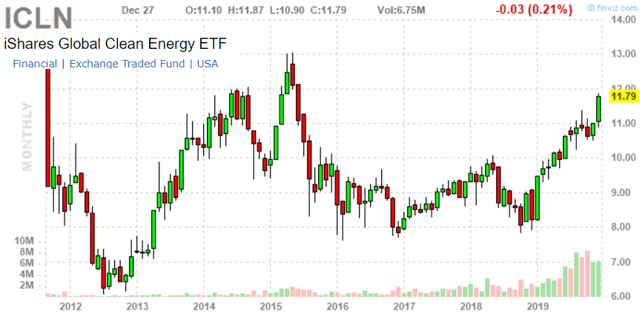The iShares S&P Global Clean Energy Index ETF (NASDAQ:ICLN) with $424 million in total assets offers investors exposure to a basket of companies that produce energy from solar, wind, and other renewable sources. With a greater awareness over the scarcity of natural resources, governments and policy makers have incentivized clean energy initiatives, which is likely to continue going forward. Favorably, recent advancements in technology have made energy from these renewable sources like wind and solar not only competitive with conventional fuels, but also in most cases cheaper and more efficient. The fund has been a big winner in 2019, up 45% gaining momentum and now trading at its highest level since 2015. This article discusses a number of key trends supporting clean energy and our views on the ICLN ETF.
(Source: Finviz.com)
Background
What we like about the iShares S&P Global Clean Energy Index ETF is a generally diversified exposure to both wind and solar which each have a number of positive attributes as sources of renewable energy depending on the application and circumstance. The fund also considers companies with significant hydropower and biofuels exposure as for clean energy. It's generally recognized there is room in the market for all types of clean energy and the ICLN fund better captures these trends compared to the more specific Invesco Solar Portfolio ETF (TAN) which only invests in solar stocks for example.
Investors should recognize that clean energy is a global trend and the constituents of the ICLN ETF include a number of foreign stocks at different parts of the supply chain. In this regard, the fund features holdings across sectors including stocks in technology, equipment manufacturing of wind/solar components, and also the power utility companies. While 38% of the fund is based on U.S. companies, there is an international diversification with companies from China representing 15.7% as the second largest
